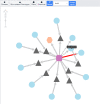RSDB: A rare skin disease database to link drugs with potential drug targets for rare skin diseases
- PMID: 36028515
- PMCID: PMC9418253
- DOI: 10.1038/s41597-022-01654-2
RSDB: A rare skin disease database to link drugs with potential drug targets for rare skin diseases
Abstract
Rare skin diseases include more than 800 diseases affecting more than 6.8 million patients worldwide. However, only 100 drugs have been developed for treating rare skin diseases in the past 38 years. To investigate potential treatments through drug repurposing for rare skin diseases, it is necessary to have a well-organized database to link all known disease causes, mechanisms, and related information to accelerate the process. Drug repurposing provides less expensive and faster potential options to develop treatments for known diseases. In this work, we designed and constructed a rare skin disease database (RSDB) as a disease-centered information depository to facilitate repurposing drug candidates for rare skin diseases. We collected and integrated associated genes, chemicals, and phenotypes into a network connected by pairwise relationships between different components for rare skin diseases. The RSDB covers 891 rare skin diseases defined by the Orphanet and GARD databases. The organized network for each rare skin disease comprises associated genes, phenotypes, and chemicals with the corresponding connections. The RSDB is available at https://rsdb.cmdm.tw .
© 2022. The Author(s).
Conflict of interest statement
The authors declare no competing interests.
Figures



Similar articles
-
eRepo-ORP: Exploring the Opportunity Space to Combat Orphan Diseases with Existing Drugs.J Mol Biol. 2018 Jul 20;430(15):2266-2273. doi: 10.1016/j.jmb.2017.12.001. Epub 2017 Dec 10. J Mol Biol. 2018. PMID: 29237557 Free PMC article.
-
RSDB: representative protein sequence databases have high information content.Bioinformatics. 2000 May;16(5):458-64. doi: 10.1093/bioinformatics/16.5.458. Bioinformatics. 2000. PMID: 10871268
-
Integrative rare disease biomedical profile based network supporting drug repurposing or repositioning, a case study of glioblastoma.Orphanet J Rare Dis. 2023 Sep 25;18(1):301. doi: 10.1186/s13023-023-02876-2. Orphanet J Rare Dis. 2023. PMID: 37749605 Free PMC article.
-
In silico repositioning of approved drugs for rare and neglected diseases.Drug Discov Today. 2011 Apr;16(7-8):298-310. doi: 10.1016/j.drudis.2011.02.016. Epub 2011 Mar 1. Drug Discov Today. 2011. PMID: 21376136 Review.
-
Drug Repurposing for Rare Diseases.Trends Pharmacol Sci. 2021 Apr;42(4):255-267. doi: 10.1016/j.tips.2021.01.003. Epub 2021 Feb 6. Trends Pharmacol Sci. 2021. PMID: 33563480 Review.
Cited by
-
The impact of COVID-19 pandemic on dermatology patients with rare skin diseases.Dermatol Reports. 2024 Feb 2;16(4):9879. doi: 10.4081/dr.2024.9879. eCollection 2024 Nov 21. Dermatol Reports. 2024. PMID: 39669880 Free PMC article.
-
A Narrative Review of Molecular, Immunohistochemical and In-Situ Techniques in Dermatopathology.Br J Biomed Sci. 2024 Dec 17;81:13437. doi: 10.3389/bjbs.2024.13437. eCollection 2024. Br J Biomed Sci. 2024. PMID: 39741925 Free PMC article. Review.
-
RDBridge: a knowledge graph of rare diseases based on large-scale text mining.Bioinformatics. 2023 Jul 1;39(7):btad440. doi: 10.1093/bioinformatics/btad440. Bioinformatics. 2023. PMID: 37458501 Free PMC article.
-
Acenocoumarol, an Anticoagulant Drug, Prevents Melanogenesis in B16F10 Melanoma Cells.Pharmaceuticals (Basel). 2023 Apr 17;16(4):604. doi: 10.3390/ph16040604. Pharmaceuticals (Basel). 2023. PMID: 37111361 Free PMC article.
References
-
- Simone Baldovino M, Domenica Taruscio M, Dario Roccatello M. Rare diseases in Europe: from a wide to a local perspective. Sat. 2016;12:20. - PubMed
Publication types
MeSH terms
Grants and funding
- MOST109-2823-8-002-010-CV, MOST 109-2320-B-002-040-, MOST 110-2320-B-002-038-/Ministry of Science and Technology, Taiwan (Ministry of Science and Technology of Taiwan)
- MOHW110-FDA-D-114-000611/Ministry of Health and Welfare, Taiwan | Food and Drug Administration (Taiwan Food and Drug Administration)
- NTU-CC-110L890803, NTU-110L8809/National Taiwan University (NTU)
LinkOut - more resources
Full Text Sources
Medical
Miscellaneous

